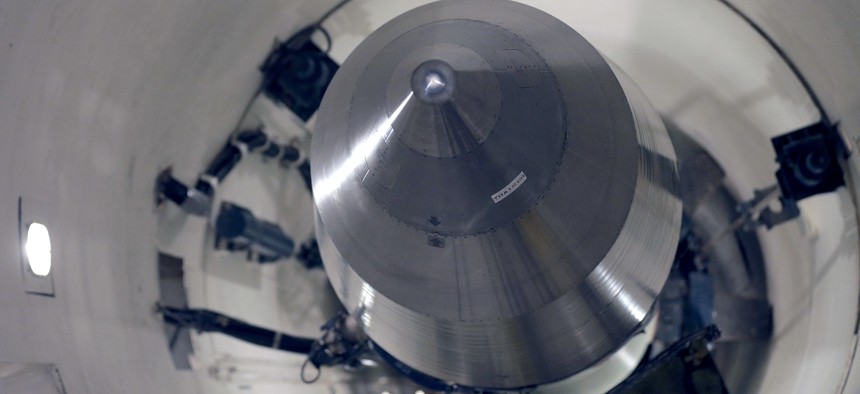
An inert Minuteman III missile in a training launch tube at Minot Air Force Base, N.D. in this file photo from June 25, 2014. AP Photo/Charlie Riedel
New Nuclear Missiles' Cost Estimate Changes Again
The fight over America’s nuclear missile future gets cloudier, as Air Force says expensive silo improvements would be needed for any new ICBMs.
The projected cost of new intercontinental ballistic missiles is expected to rise due to improvements needed to the Cold War-era silos that house the weapons, the commander of the U.S. Air Force nuclear weapons arsenal said Wednesday.
But, Gen. Timothy Ray, head of Air Force Global Strike Command, said the price tag for the ICBMs — and the cost to maintain them over decades — is expected to be less than predicted.
The sum total of those changes means taxpayers should get a cheaper ICBM program than previously expected.
“Our estimates are in the billions of [dollars in] savings over the lifespan of the weapon,” Ray said Wednesday at a Defense Writers Group breakfast in Washington.
But it all depends who you ask. The Pentagon’s Cost Assessment and Program Evaluation, or CAPE, office has estimated the new ICBM cost at $85 billion. The Air Force previously had said it expected the project to cost $62 billion. Other cost estimates project the price tag as high as $150 billion. And a new Pentagon cost estimate for the project is expected in June, InsideDefense reports.
Related: The Biggest Nuclear Threats of 2018 Will Follow Us into the New Year
Related: Nuclear Command Network Would See Comprehensive Upgrade Under Trump Plan
The cost of nuclear weapons modernization has gained renewed attention this year, particularly with the Democratic takeover of the House. New House Armed Services Committee Chairman Adam Smith, D-Wash., has questioned the cost and need for the entire nuclear triad (of submarines, bombers, and missiles that deliver the weapons), most often criticizing buying new ICBMs. The general’s comments this week come as Congress prepares to review the Pentagon’s fiscal 2020 budget request, which includes $570 million for the new ICBMs.
“The ICBM leg of the triad is the least valuable leg of the triad and plans to sustain it should reflect this reality,” said Kingston Reif, a nuclear weapons expert at the Arms Control Association, which seeks to reduce nuclear arsenals. “Spending $85 billion to $150 billion to a build a new ICBM system does not reflect this reality and will pose a major affordability challenge for the Air Force.”
Boeing and Northrop Grumman are each designing new ICBMs under a projected called Ground-Based Strategic Deterrent. The Air Force is expected to choose a winning design in late 2020, Ray said Wednesday.
“When industry competes ... then the price comes down,” he said.
One factor contributing to the price reduction is digital engineering which “is letting us realize tens of billions [of dollars] in savings,” Ray said. And the new missiles are being designed with modular parts, so they can receive upgrades more efficiently. And the project is advancing quickly. “Typically, by this stage, you would be on your second design cycle … we’re past nine with both contenders and the insights are incredible,” he said.
Another reason the new ICBMs will cost less, Ray said, is because they will not need to be removed from their silos for maintenance as often as the current Minuteman III. This is an intensive process, in which specially designed semi trucks lift the 79,000-pound missiles out of the ground, and drive them in large, armored convoys to nearby Air Force bases.
As part of their final bids, Boeing and Northrop will have to present a plan for updating the silos that house the ICBMs and the underground launch control centers where the airmen sit on alert should the president give the order for a nuclear strike.
Ray called the new ICBM effort “the program I am most pleased with from an acquisition standpoint.”
Still, the Arms Control Association, in a new report, argues that the Pentagon should explore options other than buying new ICBMs, such as maintaining the existing Minuteman III.
“The Air Force has yet to demonstrate that sustaining the Minuteman III beyond the missiles’ expected retirement in the 2030 timeframe is not a viable or more cost-effective nearer-term option,” Reif said. “CAPE should also be asked to evaluate the feasibility and cost of extending the Minuteman III.”
